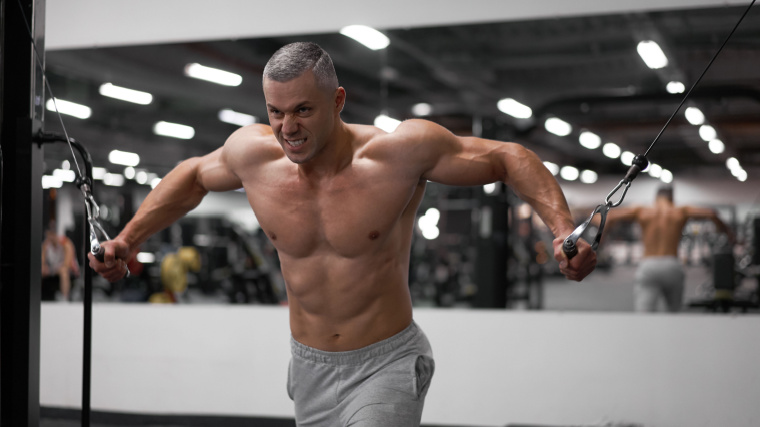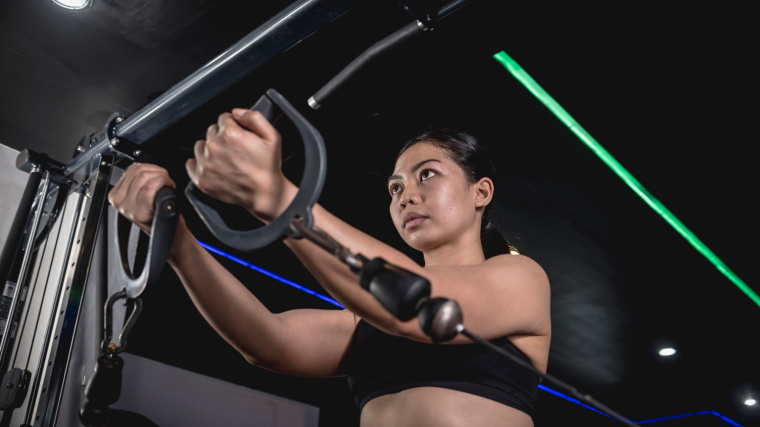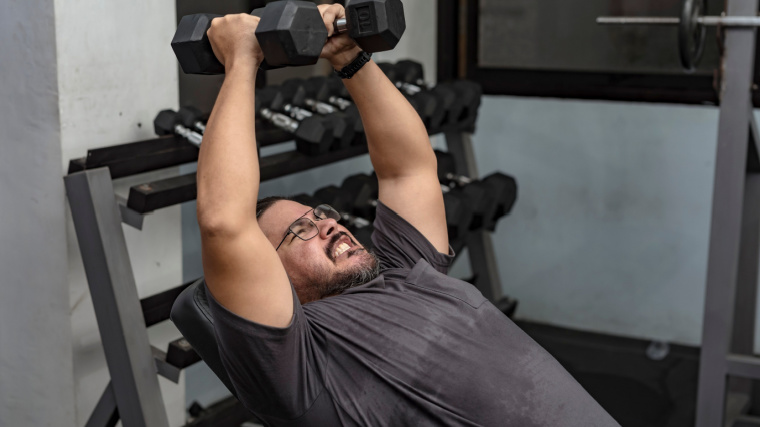Building your chest takes more than the bench press. If you’re in the midst of crafting a picture-perfect workout routine, you’re probably going to make a pit stop at the pecs at some point. Plug in your favorite presses, sure, but what of your accessory work?
You’ll generally see people perform some type of flye during chest-oriented workouts, and for good reason. It’s a great way to isolate your chest for muscle growth and strength gains. But it does beg the question — are dumbbells the best option, or should you head for the cable tree?

Here’s everything you need to know about the differences and similarities of the dumbbell flye and cable flye so you can make an informed decision about which one is right for you.
Editor’s Note: The content on BarBend is meant to be informative in nature, but it should not be taken as medical advice. When starting a new training regimen and/or diet, it is always a good idea to consult with a trusted medical professional. We are not a medical resource. The opinions and articles on this site are not intended for use as diagnosis, prevention, and/or treatment of health problems. They are not substitutes for consulting a qualified medical professional.
Differences Between the Dumbbell Flye and Cable Flye
As two single-joint isolation exercises, the dumbbell and cable flyes are more similar than they are different. However, your equipment of choice will influence how you perform each exercise — and what benefits you stand to gain from them.
Loading Potential
The amount of resistance you apply to your chest in the dumbbell flye will be limited by two factors; the strength of your chest, and the actual weight of the dumbbells you have access to.
Most dumbbell sets generally come in five-pound increments. If you’re lifting in kilograms, you’ll often see two or three-kilogram jumps in weight. Some facilities may have finer selections with single-kilo or two-and-a-half-pound dumbbells.
However, as you get stronger, you may find it difficult to jump from, say, the 25s to the 30s. Cable trees, on the other hand, may be easier to handle, even if you can’t lift quite as heavily.
Ease of Access
To perform the cable flye, you’ll need two separate pulley stations that are a sufficient difference apart such that you can stand between them with your arms extended. That might be a tall order in some cases, depending on how well-furnished your gym is, or how many people are on the floor at once.

Conversely, to perform dumbbell flyes, you really only need dumbbells and a bench to lie on. This generally means that dumbbell flyes are a better grab-and-go option, especially if you’re pressed for time.
Resistance Curve
When you perform the flye motion with a pair of dumbbells, you’ll notice a very inconsistent resistance curve. The exercise should be quite easy when your arms are pointed at the ceiling, but becomes rapidly more difficult as you open your arms out wide.
On the other hand, cables will provide consistent tension throughout the entire range of motion, since you aren’t working directly against gravity. It won’t be perfect, but you should have a ‘smoother’ lifting experience if you opt to work with cables.
Joint Strain
Free weights, cables, or even machines can all induce potential joint ailments if you push yourself too hard, too fast. That said, you may find yourself more susceptible to pain in the elbow, wrist, or shoulder if you opt for dumbbell flyes instead of using cables.
Stabilizing a free weight in space requires more fine motor control than holding onto a fixed pulley. If you’re performing flyes while fatigued or you try to lift weights that are too heavy, you may put yourself at risk of tweaking something.
Dumbbells are in no way inherently unsafe, but you should take care when you work with them, especially if you’re new to resistance training.
Line of Pull
Performing flyes with cables will afford you more options in how you physically execute the movement. When you use dumbbells, there’s a bit of wiggle room regarding how exactly your arm falls outward, but not much.

On the other hand, a vertical cable tree allows you to fix the pulley at exactly the right point for your chest. This may be about shoulder-height, or a little higher in some cases. Or, you can drop the attachment all the way down to the floor and pull from there instead.
Similarities Between the Dumbbell and Cable Flye
Luckily, both the dumbbell flye and cable flye absolutely annihilate your chest. So, which one you pick is more of a personal preference than a make-or-break decision. Here are a few ways in which the two exercises align.
Loading Potential
While the quality of the load applied to your chest during the flye will vary depending on your equipment of choice, both the dumbbell and cable flye have a relatively low strength ceiling.
This is largely due to the fact that both are isolation movements. So, your chest must bear all of the burden itself, without assistance from secondary muscles like the triceps or anterior deltoid.
Further, flyes also have a long moment arm — there’s a lot of distance between the weight in your hand and the shoulder joint that bears load. This will naturally limit the amount of absolute weight you can work with.
Motor Pattern
Both the dumbbell and cable flye involve the same motor pattern; the physical action of moving a segment of your body in space. One of your pecs’ primary functions is shoulder or humeral adduction — bringing your arm inward toward your midline.
The pecs are uniquely suited to this task because of their anatomical design. The muscle fibers sit mostly horizontally on your torso, creating a direct line of pull when your arm is held aloft at your side.
This is also why flye movements effectively remove your front delts from the equation. The fibers of the anterior shoulder run vertically, making them ineffectual at pulling your arm horizontally through space.
Muscle Recruitment
Nearly-identical motor patterns will also mean that your muscular recruitment is quite similar, whether you perform flyes with cables or a pair of dumbbells. Both exercises will involve your pectoral muscles above any other single tissue.

You may notice a bit more tension placed upon your shoulder girdle if you do flyes with dumbbells, since muscles like your middle trapezius, infraspinatus, or rear deltoid must contract to stabilize the joint.
Ease of Use
Both the dumbbell and cable flye are relatively simple exercises. You only move one joint at a time, and for the most part, work only one muscle. This makes the flye — no matter what equipment you use — a great introductory chest exercise, especially if you’re not ready to dive into something more intricate like the bench press.
Dumbbell Flye vs. Cable Flye Technique
Both the dumbbell and cable flyes involve crossing your arms in front of your torso, but each comes with plenty of nuance behind their respective techniques. Here’s how to pump out picture-perfect flyes, no matter your equipment of choice.
How to Do the Dumbbell Flye
Dumbbell flyes are easy to learn but difficult to master. Once you understand the nuts and bolts of the technique, you can begin tweaking it to suit your structure. Here are the basics.
- Grab a pair of light dumbbells and sit on the end of a weight bench.
- Lie backward and reach your arms upward, holding the weights directly above your shoulder, palms facing each other.
- From here, slowly separate the dumbbells and lower your arms out to the sides. Descend until your upper arm is about parallel with the floor, and then reverse the motion.
- Think about showing the inside of your arm to the ceiling to help maintain an externally-rotated shoulder.
How to Do the Cable Flye
To pump out some cable flyes, you’re going to need access to a cable station. Most gyms will have cable trees that allow you to adjust the height and angle of the pulley. Take some time to fiddle with the station until you find an angle that’s comfortable for your body; you can start by fixing the attachments around shoulder height.
- Grab each handle of the cable station in your hands and take a slight step forward to pull the plates off the stack.
- You can stand with your feet parallel to each other, or stagger them to improve your balance.
- From here, draw the handles across your body toward your midline, keeping your elbows mostly straight the whole time.
- Once your arms are parallel to each other extended in front of your torso, pause for a beat and then reverse the motion.
- Allow the cables to really stretch your chest muscles out as you return to the starting position.
When to Do the Dumbbell or Cable Flye
First of all, there’s no reason you can’t use both if you want to. Alternating your accessory movements is a great way to ensure your workouts stay fresh and fun. However, there are certainly some cases in which you’d want to opt for the dumbbell flye over the cable flye, or vice-versa.
For Muscle Growth
The recipe for muscular hypertrophy is simple enough — apply as much mechanical tension as possible, introduce some tissue damage, and steadily push yourself through heavier weights, higher reps, or more precise technique.
As such, both the dumbbell and cable flye fit the bill as suitable chest exercises for growth. You may find that you get a better contraction with cables and can “feel your chest” more than when using dumbbells. If chest gains are priority one, consider going for the cable tree.
As a Beginner
There are pros and cons to the dumbbell and cable flye alike for beginning gymgoers. Cables take less effort to work with, are a bit more intuitive, and can really help you isolate the target muscle. Conversely, dumbbells (and other free weights) ask more of you than just how hard you can contract your chest.
Working with dumbbells early into your gym career will help you develop robust stability, isometric control at the shoulder, and good proprioception — a sense of where your limbs are in space. Dumbbells provide immense amounts of tactile feedback that should carry over to other forms of resistance training.
In a Busy Gym
You may be a cable tree fanatic (for good reason) but getting ahold of the station can be a tall order in a busy gym.
Simply put, the dumbbell flye requires less physical space to perform and the equipment you need is more readily available; there are often many available benches in a weight room, but only one or two cable stations. If the cables are occupied, you’re out of luck. Go for the dumbbell rack instead.
Crush Your Chest
The gains you make in the weight room are only as good as the exercises you perform (and the effort you put in). If you don’t have the right movements in your pocket on chest day, how can you expect to build pecs to be proud of?
Dumbbells help you train your chest, sure. But they also teach you how to control an unstable weight and can build up your joint integrity in the process. Cable flyes? Second-to-none for targeted, consistent tension on the chest. Both have their place, and context is key: Make sure you’re using the right tool for the job when you set foot in the gym.
Featured Image: andreonegin / Shutterstock